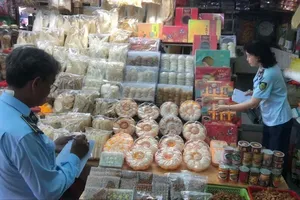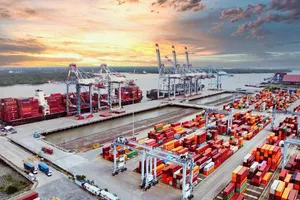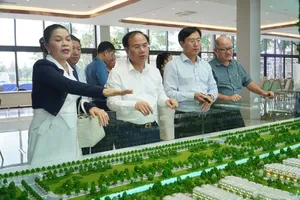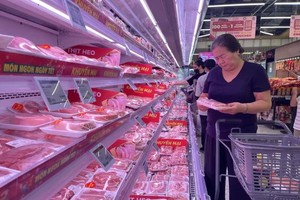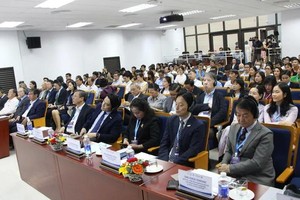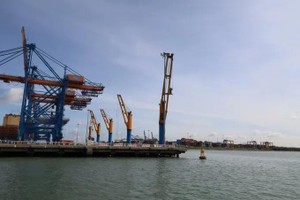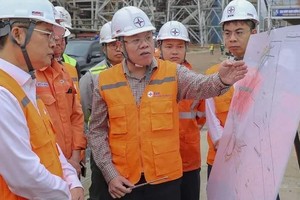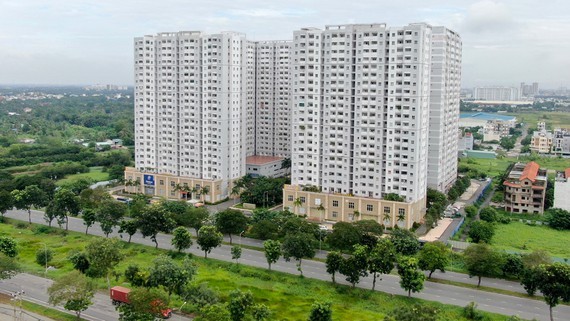 The HQC Plaza Social Housing Apartment Complex, located in Nguyen Van Linh Boulevard in An Phu Tay Commune of Binh Chanh District. (Photo: SGGP)
The HQC Plaza Social Housing Apartment Complex, located in Nguyen Van Linh Boulevard in An Phu Tay Commune of Binh Chanh District. (Photo: SGGP)
Supply-demand mismatch
According to a report by the Department of Construction of Ho Chi Minh City, in the past five years, the city only had about 20 social housing projects put into use with over 15,000 apartments. This number remains modest compared to the demand for affordable housing. One of the large-scale social housing projects that have been put into use recently is the HQC Plaza Social Housing Apartment Complex, located in Nguyen Van Linh Boulevard in An Phu Tay Commune of Binh Chanh District. The project has 1,735 apartments and utilities, such as a commercial center, school, kindergarten, polyclinic, supermarket, playing ground, and parking area. The area of each apartment here is from 54 square meters to 68 square meters, with the price ranging from VND800 million to VND1 billion per unit. Mr. Truong Anh Tuan, Chairman of Hoang Quan Real Estate Joint Stock Company (HQC), said that most customers buying apartments here are State workers. With a relatively low selling price and policies on loans and interest rates, the project was sold out quickly. Another project is the HOF-HQC Social Housing Project in Ho Hoc Lam Street in Binh Tan District, with a scale of 464 apartments invested by the HCMC Housing Development Fund, which has also been completed and put into use at full capacity. According to statistics of the HCMC Department of Construction, among the total number of houses of real estate development projects in the 2016-2020 period, there were 47,837 luxury apartments with prices over VND40 million per square meter, accounting for 33.6 percent; 65,920 mid-end apartments with prices from VND25 million to VND40 million per square meter, accounting for 46.4 percent; 28,295 affordable apartments with prices under VND25 million per square meter, accounting for 19.9 percent. Notably, in 2020, the number of affordable apartments plummeted heavily, accounting for only 1 percent of total housing products. In the first quarter of 2021 alone, the proportion of high-class, luxury, and super-luxury housing accounted for 59 percent, and mid-end housing accounted for 41 percent. However, there were no affordable apartments on the HCMC real estate market. According to the HCMC Real Estate Association, the structure of housing products is a clear sign of "supply-demand mismatch". The development of the real estate market is unbalanced and unsustainable due to the lack of affordable housing and signs of an oversupply of high-end housing.Ten years for completion of the project procedures According to the plan of Ho Chi Minh City, in the 2021-2025 period, it is expected to develop about 24,000 new social housing apartments and houses for low-income people. Accordingly, the city has 19 social housing projects expected to be completed from 2021 onwards. Moreover, the city has 65 commercial housing projects, of which 20 percent land fund (over 197 hectares) has been determined to build social housing with more than 146,000 units. Thus, by 2025, it is expected that more than 170,000 social housing units will be put into use. However, how to attract the sources of social capital to invest in social housing projects is a big problem. Previously, a real estate enterprise used to propose to switch its commercial housing project to social housing. However, after handling the procedures for a while, this enterprise had to apply for the project to be converted back to commercial housing. “The procedures for the commercial housing project and social housing project are almost the same. Besides some incentives, for social housing projects, the investor is also subject to profit control. The social housing project must go through a time-consuming process of auditing. Meanwhile, for commercial housing projects, enterprises can decide on their selling prices, balance input, output, and cost price," the director of a real estate company said. Or the Nam Ly social housing project in Phuoc Binh Ward in District 9 (which is now Thu Duc City) invested by Thao Dien Real Estate Company covering an area of 4,557 square meters is expected to build a 26-story apartment building and one basement, with a total of 291 apartments. Since 2009, the company made a written request to self-invest or invest as a secondary project. It was not until 2017 that the city decided to approve the investment and the investor with the expected completion time in the third quarter of 2018. However, the Construction Management Department under the Ministry of Construction later announced the results of the appraisal of the basic design of the high-rise apartment building of the project. By the beginning of 2019, the Department of Construction of HCMC had a document on allocating land for project implementation to the company. Thus, it took the company nearly ten years for the procedures of a project. In a recent meeting with the leaders of the District Party Committee and People's Committee of District 7, Mr. Nguyen Van Nen, Politburo Member, Secretary of the HCMC Party Committee, said that someone asked him that when the pandemic was under control, what would the first thing to do, and his answer was to build social housing. According to many experts, this is a completely right and humane decision. With this policy and determination, they hope that HCMC will remove obstacles that are hindering the development of social housing for low-income people in the coming time.
Mr. Huynh Thanh Khiet, Deputy Director of HCMC Department of Construction: Encourage low-priced commercial housing and rental housing
According to the approved housing development program of the city, the capital source for social housing development is mostly socialized capital, capital of enterprises, or loans from credit institutions, estimated at 95 percent. Only the remaining 5 percent will use the State budget to invest in State-owned social housing to solve the demand for those with special difficulties. Thus, the city needs to mobilize huge resources from society to build social housing.
In the near future, the city will encourage the development of low-priced commercial housing, rental housing, and social housing to meet the great demand of society. Accordingly, projects of low-priced commercial housing and rental housing will be allowed to pay land-use fees annually to reduce financial pressure on enterprises. It will also prioritize sources of concessional loans and consider adding more subjects who implement social housing projects to be eligible for stimulus loans of the city.
The city will review the 20 percent land fund in commercial housing projects with an area of over 10 hectares to promote the construction of social housing. In case the investor fails to implement or is slow to implement, the project shall be withdrawn and assigned to a capable investor for rapid implementation, avoiding waste; use the budget collected from commercial projects in which the investor pays the equivalent of 20 percent of the social housing land fund at the project to invest in the development of State-owned social housing projects for lease; prioritize allocating capital sources and creating a clean land fund in suburban areas and public transport arteries, especially metro lines and ring roads, to develop social housing in the direction of assigning investors to use the sources of socialized capital to build social housing for rent, manage, and exploit following regulations; continue to implement and expand the subject for stimulus loans, accordingly, not only the investors of housing projects for workers but also social housing projects for rent are supported with the entire loan interest rate, but not exceeding 70 percent of construction investment capital.
Mr. Le Huu Nghia, Director of Le Thanh Real Estate Company: Simplifying investment procedures
Over the years, his company has invested in about 7,000 apartments to serve the low-income customer segment, and the products are not enough to meet the demand. However, many investment procedures for social housing projects remain cumbersome, causing businesses to lose interest when participating in this segment. For instance, some projects of his company neither use public land nor State budget capital, but they are still required to be audited. There were irrationalities that the company petitioned many times, and the city leaders personally directed relevant departments to consider and solve them. However, it took several years for them to be resolved.
Specifically, the Tan Kien Social Housing Project in Binh Chanh District was stagnant because of the land-use coefficient and population density. The company had petitioned many times, and it took many years to get the written approval for adjustment. Nevertheless, the file has been lying in Binh Chanh District for 4-5 months. He hoped the procedures would be completed after the Covid-19 pandemic. Another project is the Le Thanh An Lac social housing project for rent in Binh Tan District, which had been under construction since 2017, with a scale of 930 apartments. So far, the project has been completed and put into use. However, some problems related to land-use fees and taxes have not been resolved, although the company has repeatedly petitioned.
According to the approved housing development program of the city, the capital source for social housing development is mostly socialized capital, capital of enterprises, or loans from credit institutions, estimated at 95 percent. Only the remaining 5 percent will use the State budget to invest in State-owned social housing to solve the demand for those with special difficulties. Thus, the city needs to mobilize huge resources from society to build social housing.
In the near future, the city will encourage the development of low-priced commercial housing, rental housing, and social housing to meet the great demand of society. Accordingly, projects of low-priced commercial housing and rental housing will be allowed to pay land-use fees annually to reduce financial pressure on enterprises. It will also prioritize sources of concessional loans and consider adding more subjects who implement social housing projects to be eligible for stimulus loans of the city.
The city will review the 20 percent land fund in commercial housing projects with an area of over 10 hectares to promote the construction of social housing. In case the investor fails to implement or is slow to implement, the project shall be withdrawn and assigned to a capable investor for rapid implementation, avoiding waste; use the budget collected from commercial projects in which the investor pays the equivalent of 20 percent of the social housing land fund at the project to invest in the development of State-owned social housing projects for lease; prioritize allocating capital sources and creating a clean land fund in suburban areas and public transport arteries, especially metro lines and ring roads, to develop social housing in the direction of assigning investors to use the sources of socialized capital to build social housing for rent, manage, and exploit following regulations; continue to implement and expand the subject for stimulus loans, accordingly, not only the investors of housing projects for workers but also social housing projects for rent are supported with the entire loan interest rate, but not exceeding 70 percent of construction investment capital.
Mr. Le Huu Nghia, Director of Le Thanh Real Estate Company: Simplifying investment procedures
Over the years, his company has invested in about 7,000 apartments to serve the low-income customer segment, and the products are not enough to meet the demand. However, many investment procedures for social housing projects remain cumbersome, causing businesses to lose interest when participating in this segment. For instance, some projects of his company neither use public land nor State budget capital, but they are still required to be audited. There were irrationalities that the company petitioned many times, and the city leaders personally directed relevant departments to consider and solve them. However, it took several years for them to be resolved.
Specifically, the Tan Kien Social Housing Project in Binh Chanh District was stagnant because of the land-use coefficient and population density. The company had petitioned many times, and it took many years to get the written approval for adjustment. Nevertheless, the file has been lying in Binh Chanh District for 4-5 months. He hoped the procedures would be completed after the Covid-19 pandemic. Another project is the Le Thanh An Lac social housing project for rent in Binh Tan District, which had been under construction since 2017, with a scale of 930 apartments. So far, the project has been completed and put into use. However, some problems related to land-use fees and taxes have not been resolved, although the company has repeatedly petitioned.




